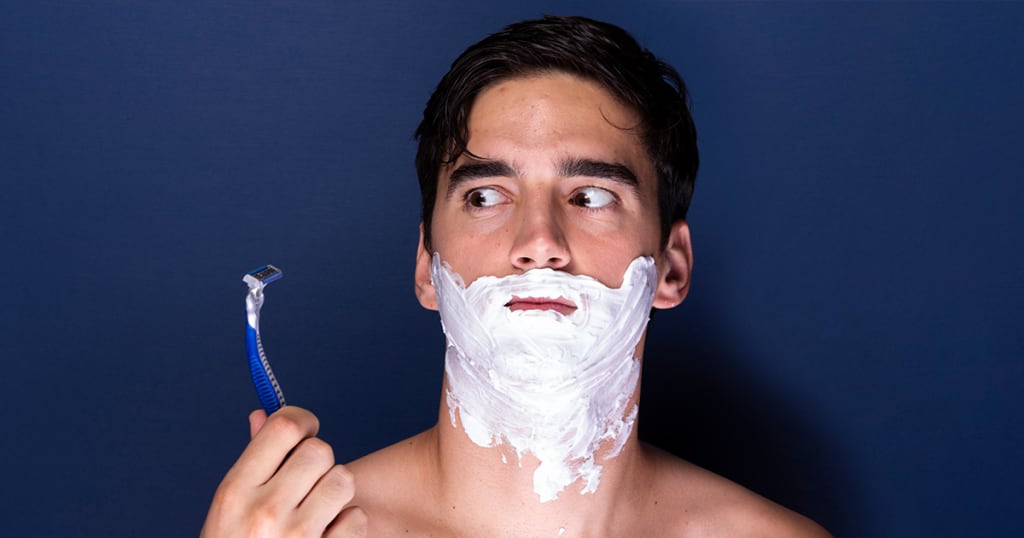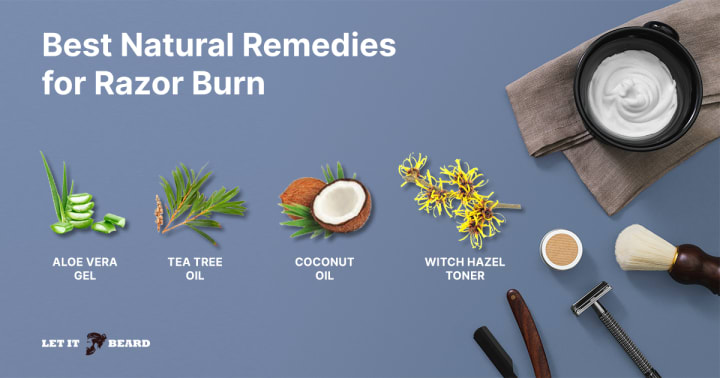How to Get Rid of Razor Burn: 3 Essential Techniques
Say goodbye to irritation and hello to a smooth, irritation-free experience with our comprehensive guide!

Razor burn is a common issue that many people face after shaving. It can cause discomfort, redness, and irritation, making it essential to know how to prevent and treat it effectively.
To prevent or get rid of razor burn, exfoliate and cleanse the skin, prepare the skin before shaving, choose suitable razors and shaving creams, and use proper shaving techniques. After shaving, rinse with cold water to close the pores and apply a soothing post-shave product for moisturizing and calming the skin.
In this ultimate guide, we will discuss various methods to help you get rid of razor burn and achieve a smooth, irritation-free shave. Whether you’re looking for natural remedies, over-the-counter treatments, or medical interventions, we’ve got you covered.
What Are the Causes of Razor Burn?
Razor burn can be caused by various factors, including shaving without a lubricant, such as soap or shaving cream, shaving against the direction of hair growth, using an old or dull razor, and shaving over dry or sensitive skin. These factors can contribute to friction, irritation, and inflammation, leading to the uncomfortable symptoms of razor burn. Let’s take a closer look at what can cause razor burn:
- Improper shaving techniques: Shaving too quickly, using excessive pressure, or shaving against the direction of hair growth can increase the likelihood of razor burn.
- Dull blades: Using a dull blade can cause more friction on the skin, leading to irritation and razor burn.
- Sensitive skin: Individuals with sensitive skin are more prone to experiencing razor burn. Their skin may react more strongly to the friction and pressure of shaving, resulting in irritation.
- Lack of lubrication: Insufficient lubrication during shaving can contribute to razor burn. Using a shaving cream or gel helps to provide a smooth surface for the razor, reducing the chances of skin irritation.
- Dry skin: Shaving on dry skin can exacerbate razor burn. It is important to hydrate the skin before shaving to minimize friction and irritation.
- Shaving over the same area repeatedly: Going over the same area multiple times with a razor can increase the likelihood of irritation and razor burn. It is important to use gentle strokes and avoid excessive repetition.
- Using harsh or irritating products: Some shaving products or aftershaves contain ingredients that can be harsh on the skin, leading to irritation and razor burn. Opting for gentle and soothing products can help prevent this.
Understanding the causes of razor burn can help individuals take proactive measures to prevent its occurrence. By adopting proper shaving techniques, one can significantly reduce the chances of developing razor burn and maintain healthier, smoother skin.
How to Prevent or Get Rid of Razor Burn?
Preventing razor burn is key to maintaining smooth and irritation-free skin. Apply these techniques to minimize the chances of experiencing razor burn:
Technique #1: Preparing for shaving
Preparing the Skin
Properly preparing your skin before shaving can make a significant difference in preventing razor burn. Follow these steps:
- Use warm water: Before shaving, cleanse your skin with warm water to soften the hair and open up the pores. This will make the shaving process smoother and less likely to cause razor burn.
- Apply a warm towel: Place a warm towel on your face for a few minutes to soften the hair and open up the pores. This step prepares your skin for a closer and more comfortable shave.
- Exfoliate: Gently exfoliate your skin before shaving to remove dead skin cells and lift any ingrown hairs. This helps prevent the razor from tugging or cutting the hair too closely, reducing the risk of irritation.
- Cleanse your skin: Use a gentle cleanser to remove any dirt, oil, or sweat from your skin before shaving. This ensures a clean surface and reduces the risk of bacteria-related irritation.
Recommended Cleanser:
👉 Hydra Energetic Daily Facial Cleanser with Charcoal by L’Oreal Paris Men Expert
Choosing the right razor and shaving cream
Selecting the right tools for shaving can help minimize razor burn. Consider the following factors when choosing your razor and shaving cream:
- Avoid dull blades: Always use a sharp razor blade to ensure a clean and precise shave. Dull blades can tug at the hair, leading to irritation and razor burn.
- Razor type: Opt for a razor that suits your skin and hair type. Some people find that using a single-blade razor or a safety razor causes less irritation compared to multi-blade razors.
- Shaving cream or gel: Use a high-quality shaving cream or gel that provides lubrication and protects your skin. Avoid products that contain alcohol or harsh chemicals, as they can dry out your skin and increase the likelihood of razor burn.
Recommended Shaving Cream:
👉 Sandalwood Shaving Cream (Irritation and Razor Burn) by The Art of Shaving
Technique #2: Shaving correctly
Proper shaving techniques play a crucial role in preventing razor burn. Follow these guidelines for a smoother shaving experience:
- Shave with the grain: Shaving against the direction of hair growth increases the risk of razor burn. Instead, shave in the same direction as the hair growth to minimize irritation.
- Light pressure: Apply gentle pressure when shaving to avoid pressing the razor too hard against your skin. Pressing too firmly can cause friction and lead to razor burn.
- Short strokes: Use short, controlled strokes while shaving. This helps maintain better control over the razor and reduces the likelihood of irritation.
Recommended Razor:
👉 Gillette Fusion ProGlide Razors for Men, Shields Against Skin Irritation
Technique #3: Using proper post-shave care products
Post-shave care is essential for soothing and hydrating your skin, reducing the chances of razor burn. Follow these steps:
- Rinse with cold water: After shaving, rinse your skin with cold water to close the pores and soothe any irritation. Cold water also helps reduce redness and inflammation.
- Apply a moisturizer: Use a gentle, non-alcohol-based moisturizer to hydrate your skin after shaving. Look for products with soothing ingredients like aloe vera or chamomile to calm any irritation.
- Avoid tight clothing: Give your skin some breathing room after shaving by avoiding tight clothing that can rub against the irritated areas. Loose, breathable clothing can help prevent further irritation.
Recommended After-shave Moisturizer:
👉 Alcohol Free Bergamot After-Shave by Imperial Barber Grade Products
Natural Remedies for Razor Burn
There are several natural remedies that can help alleviate the symptoms of razor burn and promote healing. These remedies are known for their moisturizing, soothing, anti-inflammatory, and antibacterial properties. Incorporating these natural remedies into your post-shave routine can provide relief and aid in the recovery process.

Aloe Vera Gel
Moisturizing and soothing
Aloe vera gel is a popular natural remedy for various skin conditions, including razor burn. It is renowned for its moisturizing and soothing properties, making it an excellent choice for calming irritated skin. Aloe vera gel contains vitamins, minerals, and antioxidants that can help reduce inflammation and promote skin healing. Simply apply a thin layer of pure aloe vera gel to the affected areas after shaving. Allow it to absorb into the skin for a few minutes before rinsing it off or leaving it on. The cool and soothing sensation of aloe vera gel can provide immediate relief and aid in the recovery of razor burn.
Tea Tree Oil
Anti-inflammatory and antibacterial benefits
Among oils, Tea tree oil is well-known for its anti-inflammatory and antibacterial properties, which can be beneficial for treating razor burn. It helps reduce redness, swelling, and irritation associated with razor burn while preventing infection in any cuts or nicks. However, tea tree oil should always be diluted before use to avoid skin sensitivity or adverse reactions.
Mix a few drops of tea tree oil with a carrier oil, such as coconut oil or olive oil, and apply it to the affected areas using a cotton ball or swab. Allow it to penetrate the skin for a few minutes before rinsing it off. The anti-inflammatory and antibacterial benefits of tea tree oil can help soothe razor burn and support the healing process.
Witch hazel toner
Astringent and calming properties
Witch hazel is a natural astringent that has been used for centuries to treat various skin conditions, including razor burn. It has calming and soothing properties that can help reduce inflammation and alleviate discomfort. Witch hazel also acts as a natural toner, helping to tighten the pores and reduce redness.
After shaving, soak a cotton ball or pad with witch hazel and gently apply it to the affected areas. Allow it to dry on the skin. The astringent and calming properties of witch hazel can provide relief from razor burn and promote faster healing.
Incorporating these natural remedies into your post-shave routine can help soothe and heal razor burn effectively. Remember to perform a patch test before using any new product to ensure that you are not allergic or sensitive to the ingredients. If your razor burn persists or worsens, it is advisable to consult a dermatologist for further evaluation and guidance.
Over-the-Counter Razor Burn Treatments
In addition to natural remedies, there are several over-the-counter treatments available that can effectively alleviate the discomfort and promote healing of razor burn. These treatments are easily accessible and can provide relief from symptoms such as inflammation, itching, and potential infection.
Hydrocortisone cream
Reducing inflammation and itching
Hydrocortisone cream is a common over-the-counter treatment that contains a mild corticosteroid. It is known for its anti-inflammatory properties, making it an effective option for reducing inflammation and relieving itching associated with razor burn.
Apply a thin layer of hydrocortisone cream to the affected areas after shaving, following the instructions on the product packaging. Hydrocortisone cream can help calm the skin, reduce redness, and alleviate the discomfort caused by razor burn.
Moisturizers with ingredients like shea butter or ceramides
Using moisturizers that contain nourishing ingredients such as shea butter or ceramides can help soothe and hydrate the skin, reducing redness and discomfort caused by razor burn. Look for moisturizers labeled as suitable for sensitive skin or those specifically formulated for post-shave care. After shaving and treating the affected areas, apply a generous amount of moisturizer to help restore the skin’s natural moisture barrier and promote healing. These moisturizers can provide ongoing hydration and protect the skin from further irritation.
Medical Interventions
In certain cases, when razor burn is severe or persistent, medical interventions may be recommended to address the issue effectively. These interventions are typically prescribed or performed by healthcare professionals and can provide more targeted and long-lasting solutions for razor burn.
Prescription-strength topical corticosteroids
For individuals with severe razor burn or persistent inflammation, a dermatologist may prescribe prescription-strength topical corticosteroids. These medications contain potent anti-inflammatory properties and can help reduce redness, swelling, and itching associated with razor burn. Topical corticosteroids should be used as directed by a healthcare professional and for the prescribed duration to minimize potential side effects. They can provide significant relief for individuals experiencing severe razor burn symptoms.
Laser Hair Removal
Long-term solution for reducing razor burn
Laser hair removal is a medical procedure that can offer a long-term solution for reducing razor burn. During laser hair removal, concentrated beams of light are directed into hair follicles, targeting and damaging the hair follicles to inhibit future hair growth. This procedure can be performed by a dermatologist or a trained healthcare professional. By significantly reducing or eliminating hair growth in the treated areas, laser hair removal can effectively minimize the need for shaving, thereby reducing the occurrence of razor burn.
Dermatologist-recommended skincare routines for sensitive skin
If you frequently experience razor burn or have sensitive skin prone to irritation, consulting with a dermatologist can provide valuable insights and personalized recommendations for managing and preventing razor burn. A dermatologist can assess your skin type, evaluate any underlying conditions, and tailor a skincare routine specifically for your needs. They may recommend gentle cleansers, moisturizers, and post-shave products that are suitable for sensitive skin.
Additionally, they can suggest specific shaving techniques and provide guidance on the appropriate choice of razors and shaving creams to minimize razor burn. Following a dermatologist-recommended skincare routine can help manage razor burn and promote healthier skin overall.
Post-Shave Care Routine
Proper post-shave care is essential to soothe the skin, minimize irritation, and prevent razor burn. By following a post-shave care routine, you can promote healing and maintain healthy skin. Here are some key steps to include in your post-shave care routine:
Cleansing the skin gently
After shaving, cleanse your skin gently to remove any residual shaving cream, debris, or bacteria. Use a mild and non-irritating cleanser that is suitable for your skin type. Avoid using hot water, as it can further irritate the skin. Instead, opt for lukewarm water to rinse off the shaved areas. Pat your skin dry with a clean, soft towel, being careful not to rub or irritate the skin.
Recommended Cleanser:
👉 Hydra Energetic Daily Facial Cleanser with Charcoal by L’Oreal Paris Men Expert
Applying a soothing and moisturizing product
Once your skin is cleansed and dry, apply a soothing and moisturizing product to the shaved areas. Look for products that contain ingredients known for their calming and hydrating properties, such as aloe vera, chamomile, or hyaluronic acid. These ingredients can help reduce redness, inflammation, and soothe any irritation caused by shaving. Gently massage the product into your skin until it is fully absorbed.
Recommended After-shave Moisturizer:
👉 Alcohol Free Bergamot After-Shave by Imperial Barber Grade Products
Avoiding tight clothing or abrasive fabrics
After shaving, it’s important to give your skin some breathing room. Avoid wearing tight clothing or fabrics that can rub against the freshly shaved areas, as this can lead to further irritation. Opt for loose-fitting clothing made from soft and breathable materials to minimize friction and allow your skin to heal properly.
Allowing the skin to heal before shaving again
To prevent further irritation and razor burn, it’s essential to give your skin enough time to heal before shaving again. Shaving over already irritated or sensitive skin can exacerbate the problem. It’s recommended to wait at least a few days between shaves to allow your skin to recover fully. During this time, continue to moisturize and care for your skin to promote healing and maintain its health.
Summary
In conclusion, a proper post-shave care routine is essential for preventing razor burn and maintaining healthy skin. After shaving, gently cleanse your skin with a mild cleanser and pat it dry. Then, apply a soothing and moisturizing product to calm and hydrate the skin. Avoid wearing tight clothing or abrasive fabrics that can cause friction and further irritation. It is important to allow your skin enough time to heal before shaving again. By following these steps, you can minimize the risk of razor burn, promote skin health, and enjoy a comfortable shaving experience.
---
This article is written by a grooming enthusiast and the founder of letitbeard.com, a website dedicated to all things related to beard care.
If you found this post helpful, please like and share it with others and leave your comments below the article!
About the Creator
Samir Aghayev
I am a devoted beard fan with an unbridled passion for all things beard-related. Join me and many other like-minded beard enthusiasts from all over the world, and let's take the journey from scruff to glory together!






Comments
There are no comments for this story
Be the first to respond and start the conversation.